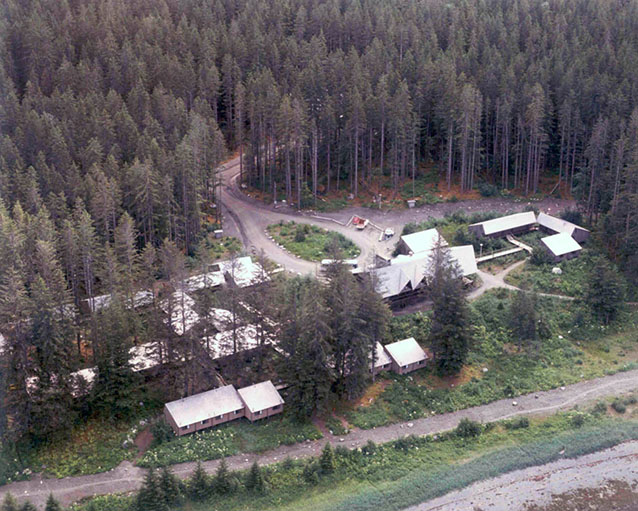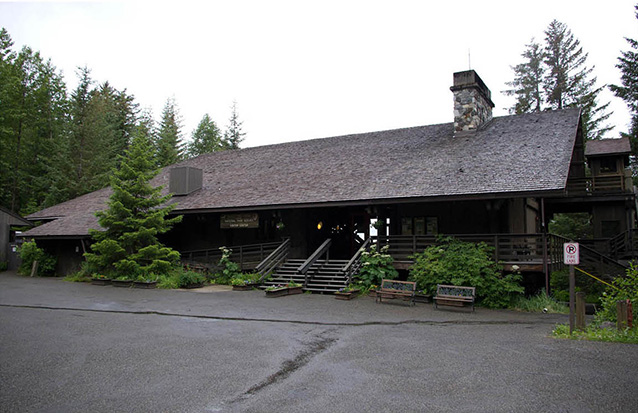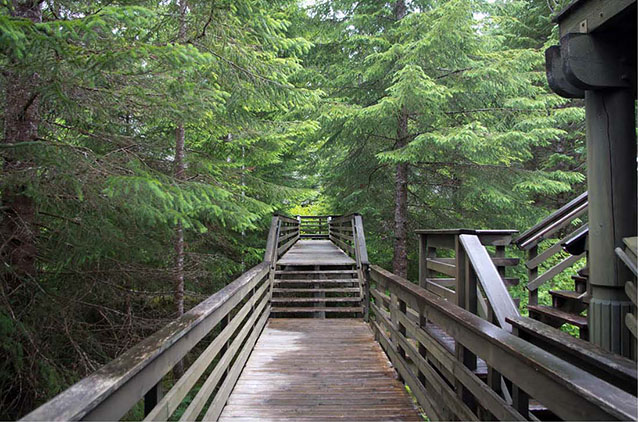Glacier Bay Lodge Complex is located in southeast Alaska, 9 miles to the northwest of the small town of Gustavus. The lodge and associated cabins sit on the south shore of Bartlett Cove near the entrance to Glacier Bay within the boundaries of Glacier Bay National Park and Preserve. The lodge complex was originally constructed to increase visitor accessibility and remains the only visitor lodging available within the park.
. . . the Glacier Bay Lodge Complex exhibits . . . design elements that provide an elegant response to the temperate rainforest environment and remind visitors of the arts and crafts traditions of the indigenous Tlingit Indians. Glacier Bay Lodge Complex: Cultural Landscape Inventory, NPS, 2011

Although the lodge had first been proposed in 1945, the project was not realized until former National Park Service Director Conrad Wirth’s Mission 66 park development program. The lodge construction began in 1965 and it was opened in June of 1966. The lodge complex was designed by Seattle based architecture firm John Morse and Associates who received an Honor Award from the Seattle Chapter of the American Institute of Architecture (AIA) in 1967 for the project followed by the Alaska Chapter of AIA Design Excellence Honor Award in 1974.

C. Welzenbach, NPS Cultural Landscapes Program, 2011
The Glacier Bay Lodge Complex consists of the main lodge, the surrounding sixteen cabins containing a total 56 guest and staff units, associated utility buildings, boardwalks which connect the lodge and cabins, forest trails, and the underlying landscape. The lodge complex was constructed in two main phases: the lodge and eight cabins containing a total of 20 bedroom units were constructed in 1965 to 66, and an additional eight cabins containing 36 units and a utility building were constructed in 1972 to 73.
The lodge is significant for its association with the Mission 66 program. Mission 66 was a ten-year park development program from 1956 to 1966 which funded modernization projects in the National Park System in order to improve visitor accessibility and services. The lodge complex also exemplifies Pacific Northwest regional modernism and Park Service Modern architectural styles.

C. Welzenbach, NPS Cultural Landscapes Program, 2011
Although the property is relatively young, its historical importance is apparent. The period of significance for the project is from 1945 (when a site investigation was conducted by National Park Service Landscape Architect Alfred Kuehl) until 1973 (when the second phase of cabins were completed).
Morse’s design intent was to integrate the buildings into the natural environment. Many significant landscape characteristics relate to the integration of the designed site with the larger landscape. The construction of the lodge complex provided both a Mission 66 version of a culturally iconic park lodge for Glacier Bay National Park and Preserve and successfully increased visitation at the relatively remote park.
Quick Facts
- Cultural Landscape Type: Designed
- National Register Significance Level: National
- National Register Significance Criteria: A,C
- World Heritage Site
- Period of Significance: 1945-1973
Landscape Links
Last updated: November 22, 2021
